Non-sanitary landfill poses enormous threats to lives. In this study, heavy metals in groundwater and soil of residential areas around Awotan landfill, Ibadan, Southwest-Nigeria were quantified and associated environmental and health risks were assessed within 1-150 m and 151-300 m radii. A total of 20 samples of groundwater and soil each were analysed for Pb, Cd, Cr, Ni, Cu, Fe and Zn using Atomic Absorption Spectrometry (AAS). Pb was above the WHO permissible limit in groundwater while Cd was above the limit only at 1-150 m radius. There was a strong correlation (p ˂ 0.05) between the metals. Except for Zn, levels of all analysed metals in groundwater and soil were proportional to proximity to the landfill as revealed by horizontal ratio (HR ˃ 1). Contamination index of individual metal revealed moderate level of contamination (1 ≤ CF ≤ 3) but pollution load index of all analysed metals in the matrices showed heavy metal pollution (PLI ˃ 1). Generally, geoaccumulation index indicated moderate pollution within 1-150 m radius (0 ˂ IGeo ≤ 2) while IGeo was ≤ 0 within 151-300 m radius (practically unpolluted). Metals were minimally to moderately enrich (0 ˂ EF ˂ 5) in the studied matrices and low ecological risk (PERI ˂ 150) was evaluated in the study area due to the landfill. However, health index calculated for the metals through ingestion and dermal absorptions was ˃ 1 while through inhalation was ˂ 1. Furthermore, children and those living close to the landfill were shown to be at higher risk than adults and those living farther away from the landfill respectively. Awotan landfill poses considerable ecological and health risks. Hence, the landfill should be sanitarily reconstructed while acceptable standards should be enforced in managing it thereafter.
Risks assessment, Heavy Metals, Groundwater, Soil, Landfill
Human population has continued to increase unabatedly with its attendant consequences such as unprecedented and enormous quantities of generated and discarded solid wastes. Consequently, many countries are faced with the challenges of waste management. In developing countries particularly, solid wastes are massively dumped in open landfills without requisite capability to manage them [1]. In cities of these countries, outskirt portion of settlements which usually become part of residential and commercial areas overtime due to community expansion are chosen as landfill. In Nigeria, improper management of solid wastes is a major environmental issue and open landfill is a common practice of waste disposal. Sadly, sanitary landfills are almost not available in the country including landfills managed by waste management agencies of government. Meanwhile, these landfill wastes contain numerous toxic chemicals such as heavy metals, polycyclic aromatic hydrocarbons (PAHs), polychlorinated biphenyls (PCBs) and other persistent organic pollutants (POPs) which contaminates adjacent soil environment and then leach into groundwater [2,3].
Groundwater is a major source of water for people living in non-riverine areas. Groundwater pollution by leachate from landfill has been a long time issue of public health concern. Runoffs, underflow of groundwater, infiltration from precipitation takes toxicants from the landfill wastes to the groundwater and soil of nearby residential area [4]. The constituents, toxicity and level of risk of a landfill leachate are dependent on the components of the waste materials and availability of impermeable under-liner and leachate collection system [5,6]. Chemical compounds in leachates pose serious risks to ecosystem and human health when the chemicals migrate to surface water, groundwater or accumulated in food source such as vegetables or fishes [7].
Heavy metal contamination has been considered as a serious environmental health issue due to their toxicity even at low concentration, persistence and bioaccumulation potential. Heavy metal contamination may have devastating effects on the ecological integrity of the receiving environment and human health [8-10]. Lead (Pb), chromium (Cr) and cadmium (Cd) are non-essential metals of serious health concern in the environment. Exposures to Pb have been implicated to cause lung cancer, mental retardation in children, anaemia and kidney dysfunction [11,12]. Cr and Cd have been reported to be hepatotoxic, neurotoxic, renal-toxic and carcinogenic [13,14]. Zinc (Zn) and copper (Cu) are essential elements for normal body growth and functioning but at high concentrations, Zn inhibits respiratory function [15] while Cu bioconcentration interferes with proper conversion of thyroid hormone and interferes with adrenal hormone production [16]. Nickel (Ni) is both essential and toxic to human depending on the exposed concentration and form. Ni is carcinogenic and also enhanced disease-causing organisms that rely on nickel-based enzyme to initiate pathogenesis [17]. Iron (Fe) plays numerous biological roles in controlling certain metabolic and signalling functions; however, its redox-active form produce oxidative stress by binding to thiols in the cell [18]. Hence, environmental management of municipal wastes which contains high concentrations of these metals is of interest to environmental scientist, public health experts, environmental policy makers and regulatory agencies.
Quantifying the environmental load of toxicants is often one of the initial steps in monitoring and management of such pollutants. Standard regulatory agencies such as World Health Organization (WHO), United State Environmental Protection Agency (USEPA), and Nigerian Environmental Standard Regulatory Agency (NESREA) etc. set permissible limits for various pollutants in the environment, above which the environment could be regarded as polluted and risky. Risk assessment is considered in ecotoxicology and ecohealth as the characterization of potential adverse effects on ecosystem and human health upon exposure to environmental toxicants. Environmental and health risk models have been employed to help identify and measure quantitatively, environmental and health hazards and to determine possible routes of exposure and represent the potential risk [19].
Environmental and risk assessment studies in Nigeria have majorly been on mining sites [20,21], fish and edible crops [22,23], but there is dearth of information regarding risk assessment associated with landfill. Few researchers such as [24] estimated the concentrations of selected metals in Awotan landfill but with no attempt at assessing the risks associated with them. This study therefore deals with the quantitative determination, environmental and health risk assessment of some heavy metals (Pb, Cd, Cr, Ni, Cu, Fe and Zn) in groundwater and soil of residential area around Awotan Landfill, Ibadan, Southwest-Nigeria.
Awotan landfill (AWL) is situated in Ibadan, Ido Local Government Area (LGA) of Oyo State, Nigeria within latitude 7° 27ꞌ47.0478''N and longitude 3° 50ꞌ56.781''E (Figure 1). The landfill is one of the largest in the state occupying an area of 81 acres. Twenty samples of groundwater and soil each were randomly collected at residential area within 1-50 m and 151-300 m distances from AWL. Groundwater and soil samples from Aduloju Estate Area of Bodija, Ibadan were obtained as controls and background values as the site has no record of environmental distortions. Samples of groundwater were collected from wells and boreholes, filtered through Whatman filter (42 µm) into pre-washed bottles and kept under 4 ℃ before analysis. Soil samples were collected from topsoil into prewashed polythene bags and transported to the laboratory. Soil samples were air-dried, pulverised and sieved with 0.5 mm mesh sieve. Acid digestion was done by adding to 3 g of the sieved fraction, 15 ml of freshly prepared mixture of HNO3/HClO4 (2:1) before heating in a fume cupboard to obtain a clear solution. Analyses of Lead (Pb), Cadmium (Cd), Chromium (Cr), Nickel (Ni), Copper (Cu), Iron (Fe) and Zinc (Zn) were done in solutions gotten from the treated samples of water and soil using Atomic Absorption Spectrophotometer (AAS).
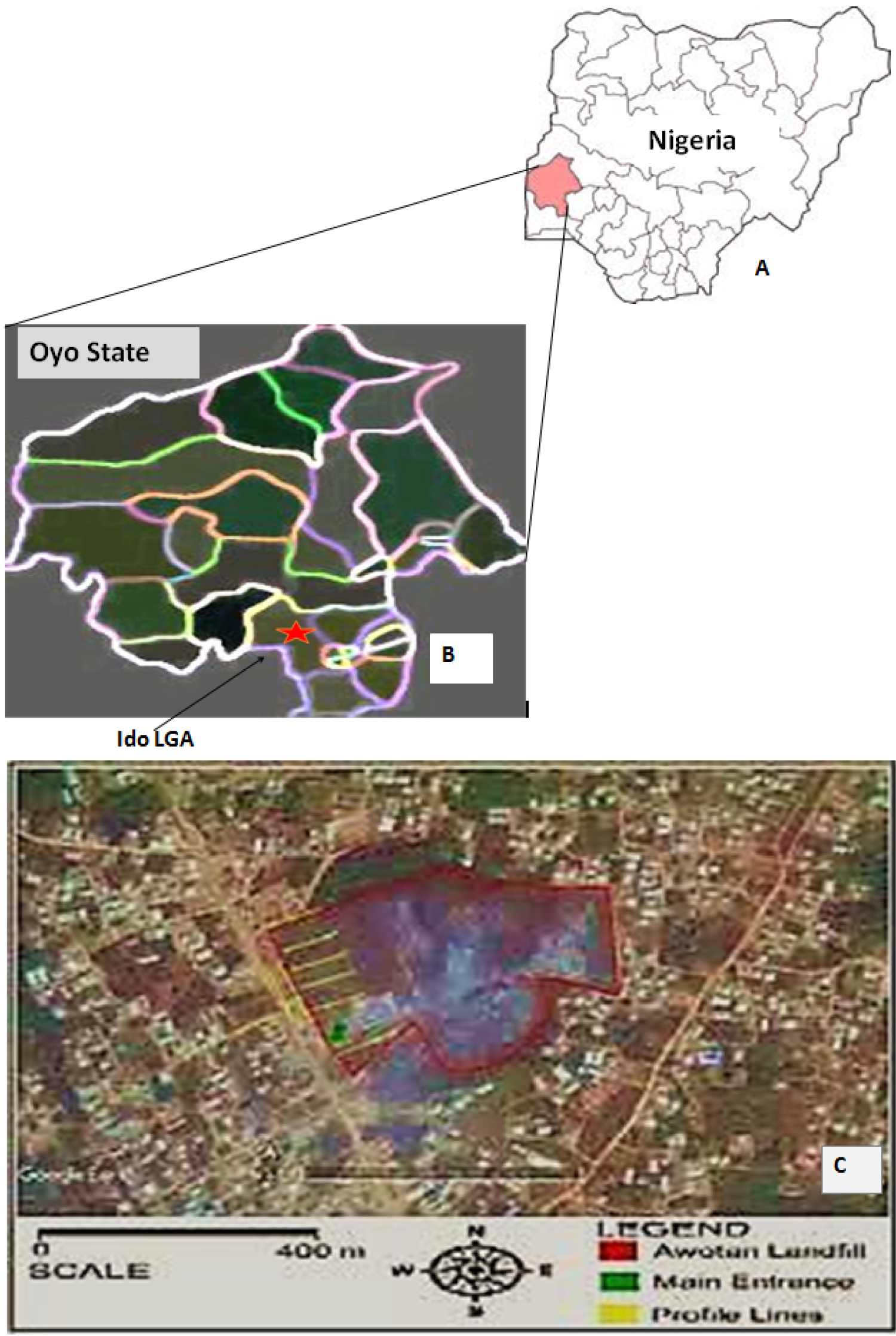 Figure 1: Map of the study area. (A-Map of Nigeria showing Oyo State; B-Map of Oyo State showing Ido LGA; C-Satellite view of Awotan landfill) [25].
View Figure 1
Figure 1: Map of the study area. (A-Map of Nigeria showing Oyo State; B-Map of Oyo State showing Ido LGA; C-Satellite view of Awotan landfill) [25].
View Figure 1
Data obtained were analysed statistically with SPSS v.20 using one way analysis of variance (ANOVA) followed by Bonferonni's Test for comparison of means. Correlation analysis was done using Pearson Correlation Test to assess elemental association in the studied site.
USEPA ERA models were employed to evaluate the environmental risks associated with heavy metals in groundwater and soil in residential area around AWL. Values of heavy metals in groundwater and soil in 1-150 m and 151-300 m radii were compared with WHO standard limits and with background values.
Horizontal ratio measures horizontal transportation of heavy metals from pollution source. CFmi is the concentration of metal in site A and CFmii is the concentration of metal in site B.
HR ˃ 1 = site A is the possible pollution source or closest to pollution source; HR v < 1 = site B is the possible pollution source or closest to pollution source and HR value of 1 = site A and Site B are independent.
CFm is the mean concentration of metal and CFb is the background value of the metal.
CF value < 1 = low contamination; CF value between 1 and 3 = moderate contamination; CF value between 3 and 6 = considerable contamination and CF value > 6 = very high contamination [26].
i.e. Cdeg = CF1 + CF2 + CF3+ ....+ CFn (4)
CFs is the contamination factors of all metals in a site. Cdeg value < 8 = low degree of contamination; Cdeg value between 8 and 16 = moderate degree of contamination; Cdeg value between 16 and 32 = considerable degree of contamination and; Cdeg value > 32 = very high degree of contamination [27].
Pollution Load Index (PLI) = (CF1 × CF2 × CF3 × ... × CFn)1/n (5)
CF is the contamination factor of metal and n is the total number of metal analysed. PLI value < 1 = no heavy metal pollution; PLI value of 1 = baseline level of pollution and PLI value > 1 = heavy metal pollution [28].
CFm is the mean concentration of metal, CFb is the background value of the metal and 1.5 is a lithological factor of variation. IGeo value < 0 = practically unpolluted; IGeo value between 0 and 1 = unpolluted to moderately polluted; IGeo value between 1 and 2 = moderately polluted; IGeo value between 2 and 3 = moderately to strongly polluted; IGeo value between 3 and 4 = strongly polluted; IGeo value between 4 and 5 = strongly to extremely polluted and; IGeo value > 5 = extremely polluted [29].
is the ratio of heavy metal to immobile element in the analysed sample and is the ratio of heavy metal to immobile element in the background sample. EF value < 2 = minimal enrichment; 2 ≤ EF ˂ 5 = moderate enrichment; 5 ≤ EF ˂ 20 = significant enrichment; 20 ≤ EF ˂ 40 = very high enrichment and EF ˃ 40 = extremely high enrichment [30]. In this study, Zirconium (Zr) median value in topsoil was used as reference immobile element.
Potential Ecological Risk Index (PERI)
is the potential ecological factor for single heavy metal while is the sum for all the metals and it is calculated by:
CFs is the contamination factor and is the response coefficient for the toxicity of single heavy metal. PERI value ˂ 150 = low risk; 150 ≤ PERI ˂ 300 = moderate risk; 300 ≤ PERI ˂ 600 = considerable risk and PERI ≥ 600 = very high risk [31]. Toxic response value for Pb, Cd, Cr, Ni, Cu and Zn are 5, 30, 2, 5, 5 and 1 respectively [32].
Hazard Quotient (HQ) and Hazard Index (HI) as indicated in USEPA risk assessment models were used to assess non-carcinogenic health risk in children and adults with regards to heavy metals in groundwater and soil in residential area around AWL. Commonest exposure routes for groundwater and soil were employed. That is, ingestion and dermal routes for groundwater while ingestion, dermal and inhalation routes for soil. Values of heavy metals in groundwater and soil in the 1-150 m and 151-300 m radii are employed for the HRA.
Ingestion route (Ing):
Dermal route (Der):
Inhalation route (Inh):
is the hazard quotient due to heavy metals in groundwater/soil; CM is the concentration of heavy metal; IngR is the ingestion rate; EF is the exposure frequency; ED is the exposure duration; BW is the body weight; AT is the average time; RFD is the reference dose of heavy metals; SA is the skin surface area; WAF is the water adherence factor; SAF is the soil adherence factor; DAF is the dermal absorption factor; InhR is the inhalation rate and PEF is the particulate emission factor.
HIing/der/inh = ∑ HQi (16)
HIing/der/inh is the hazard index for ingestion/dermal/inhalation route and HQ is the hazard quotient due to heavy metal. HI ˃ 1 indicates a potential for adverse effect [33] (Table 1 and Table 2).
Table 1: Parameters used to estimate health risk in the study area [29,34,35]. View Table 1
Table 2: Reference doses (RFD) (mg/kg/day) of heavy metals via ingestion, inhalation and dermal exposure routes used for the non-carcinogenic health risk assessment. View Table 2
The results of heavy metal analyses in groundwater and soil of residential area at 1-150 m and 151-300 m radii around AWL is summarized in Table 3. Concentration of metals were significantly different (p ˂ 0.05) between groundwater and soil as well as between radii. Pb in both GWa and GWb were found to be above the WHO permissible limit as well as the background value while high level of Cd above WHO limit was only recorded in GWa. Moreover, Ni and Cu in both GWa and GWb were within the limit but above background value. Values of all metals in soil were within WHO permissible limit. In addition, aside Zn, all analysed metals had significantly (P ˂ 0.05) higher concentration at 1-150 m radius than 151-300 m radius and in soil than groundwater. Levels of analysed metals in soil were significantly higher (p ˂ 0.05) than in groundwater. The order of heavy metal concentration in GWa and GWb were Cr ˂ Ni ˂ Cd ˂ Cu = Pb ˂ Fe ˂ Zn and Cr ˂ Cd = Ni = Cu ˂ Pb = Fe ˂ Zn respectively. The order of heavy metal concentration in Sa and Sb were Ni ˂ Cr ˂ Cd ˂ Pb ˂ Fe ˂ Cu ˂ Zn and Ni ˂ Cr ˂ Cd ˂ Cu ˂ Pb ˂ Fe ˂ Zn respectively.
Table 3: Concentrations of heavy metals (mg/l) in groundwater and soil of residential area around AWL, Ibadan, Southwest-Nigeria. View Table 3
The result of the Pearson Correlation analysis is presented in Table 4. Correlation strength between metals was in the order of Ni-Zn ˂ Cu-Fe ˂ Cr-Zn ˂ Cu-Zn ˂ Pb-Ni ˂ Ni-Fe ˂ Cd-Zn ˂ Pb-Cr ˂ Pb-Cu ˂ Cr-Fe ˂ Cd-Ni ˂ Pb-Cd = Fe-Zn ˂ Pb-Zn = Cd-Fe ˂ Cd-Cr ˂ Cd-Cu ˂ Ni-Cu = Ni-Cu ˂ Cr-Cu = Pb-Fe. There were strong to very strong positive correlations (p ˂ 0.05) among all the metals and perfect associative correlation existed between Pb-Fe and Cr-Cu.
Table 4: Correlation matrix between heavy metals in groundwater and soil of residential area at 1-150 m and 151-300 m radii around Awotan landfill, Ibadan, Southwest-Nigeria. View Table 4
Horizontal ratio (HR): The result of HR estimated is presented in Figure 2. HR in groundwater and soil were in the order of Cr ˂ Zn ˂ Ni ˂ Pb ˂ Cd = Fe ˂ Cu and Zn ˂ Pb ˂ Fe ˂ Cd ˂ Cu ˂ Cr ˂ Ni respectively. The highest HR which was 2.5 was recorded for Cu in groundwater and except for Zn with horizontal ratio (HR) that was less than 1, all metals analysed in both groundwater and soil had HR ˃ 1, that is; there were higher concentration of the metals at 1-150 m radius than 151-300 m radius.
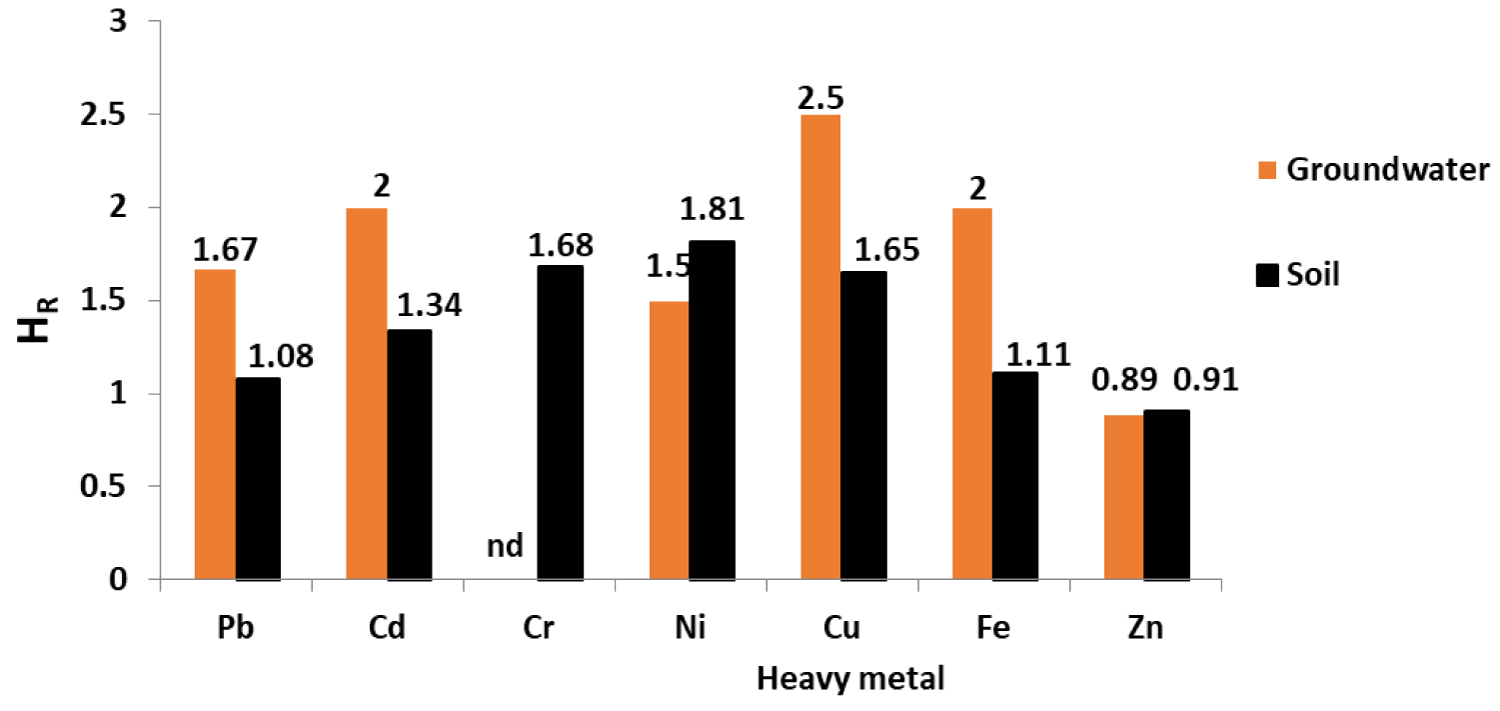 Figure 2: Horizontal ratio of heavy metals in groundwater and soil of residential areas around Awotan landfill, Ibadan, Southwest-Nigeria.
*nd = not determined.
View Figure 2
Figure 2: Horizontal ratio of heavy metals in groundwater and soil of residential areas around Awotan landfill, Ibadan, Southwest-Nigeria.
*nd = not determined.
View Figure 2
Contamination Factor (CF), Degree of Contamination (Cdeg) and Pollution Load Index (PLI): Result presented in Table 5 show the CF, Cdeg and PLI of analysed metals. CF ranged from 1.50-2.67, 0.67-3.00, 1.47-4.24, 0.94-1.81 in GWa, GWb, Sa and Sb respectively. Cu had the highest CF in Sa while aside Cr which was not detected in the GWa, the same metal-Cu recorded the lowest CF in the GWb. All the studied matrices had moderate contamination except Zn in the GWb, Cu in the GWa and Ni in the Sb which had considerable contamination, low contamination and low contamination respectively. In addition, results of Cdeg showed that heavy metals impacted moderate degree of contamination with the highest degree on Sa, Sb and GWa compared to GWb in the order of Sa ˃ GWa ˃ Sb ˃ GWb. PLI was ˃ 1 in GWa, GWb, Sa and Sb with values of 2.01, 1.17, 1.96 and 1.47 respectively.
Table 5: Contamination Factor (CF), Degree of Contamination (Cdeg) and Pollution Load Index (PLI) of heavy metals in groundwater and soil of residential area around Awotan landfill, Ibadan, Southwest-Nigeria. View Table 5
Geoaccumulation Index (Igeo): As shown in Figure 3, there was practically no pollution (Igeo ˂ 0) by: Pb and Cd in soil (both in Sa and Sb) and GWb; Cr, Ni, Cu and Fe in GWb; Ni in GWa and; Ni and Fe in Sb. However, moderate pollution was recorded at other points of the matrices by the metals. Cu accounted for the highest IGeo (1.5) at Sa which corresponds to its highest CF at this same matrix. On the average across all the matrices, Zn had the highest IGeo (0.56) while the least was Cd (-0.01). Furthermore, the mean value of IGeo of metals in the matrices showed that GWb and Sb were practically unpolluted with values of -0.27 and -0.02 respectively while GWa and Sa were moderately polluted with values 0.43 and 0.39 respectively.
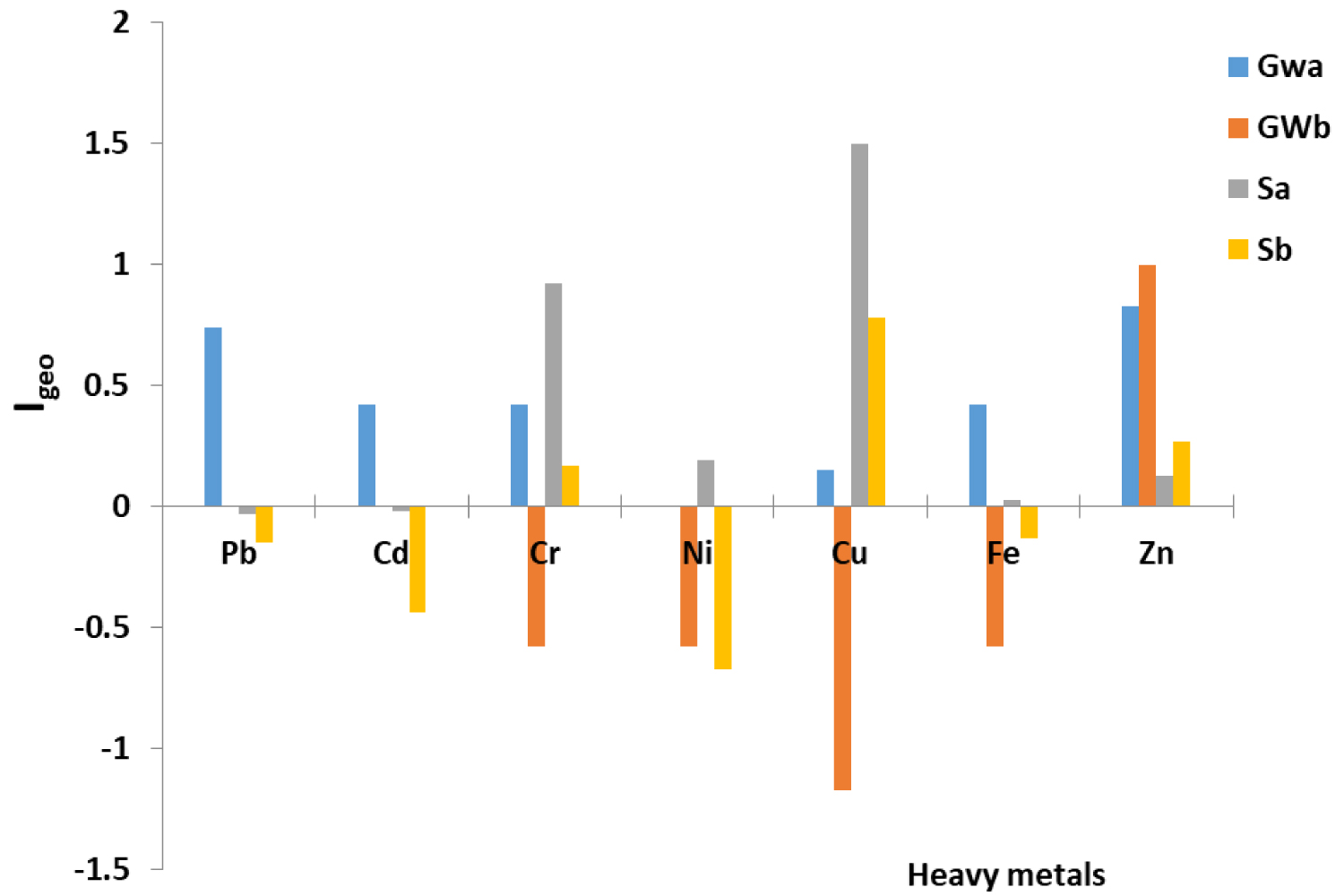 Figure 3: Geoaccumulation Index (Igeo) of heavy metals in groundwater and soil of residential area around Awotan landfill, Ibadan, Southwest-Nigeria.
View Figure 3
Figure 3: Geoaccumulation Index (Igeo) of heavy metals in groundwater and soil of residential area around Awotan landfill, Ibadan, Southwest-Nigeria.
View Figure 3
Enrichment Factor (EF): Figure 4 shows the EF for the metals at 1-150 m and 151-300 m radii of residential area around Awotan landfill, Ibadan, Nigeria. Cu (EF = 4.26) was the most enriched metal in Sa while Zn (EF = 3.01) is the most enriched in the groundwater but at the 151-300 m radius. EF of Pb ranged between 1.36 in Sa to 2.51 in GWa. Cd and Ni EF ranged between 1-2.01 and 0.95-1.71 respectively. Cr which was not detected in GWb but had its highest EF in the Sa. Cu and Fe had their lowest EF (0.67 and 1 respectively) in GWb and their highest as 4.26 and 2.01 respectively. At the average, the EF of metals in all the matrices is in the order of Ni ˂ Cd ˂ Fe ˂ Cr ˂ Pb ˂ Zn ˂ Cu. There were minimal to moderate enrichment of metals in the studied matrices. All metals had moderate enrichment in GWa except for Ni and Cu with minimal enrichment. Meanwhile, all metals in the soil (in both radii) and GWb had minimal enrichment except for Zn in the groundwater, Cu in soil in both radii and Cr in Sa.
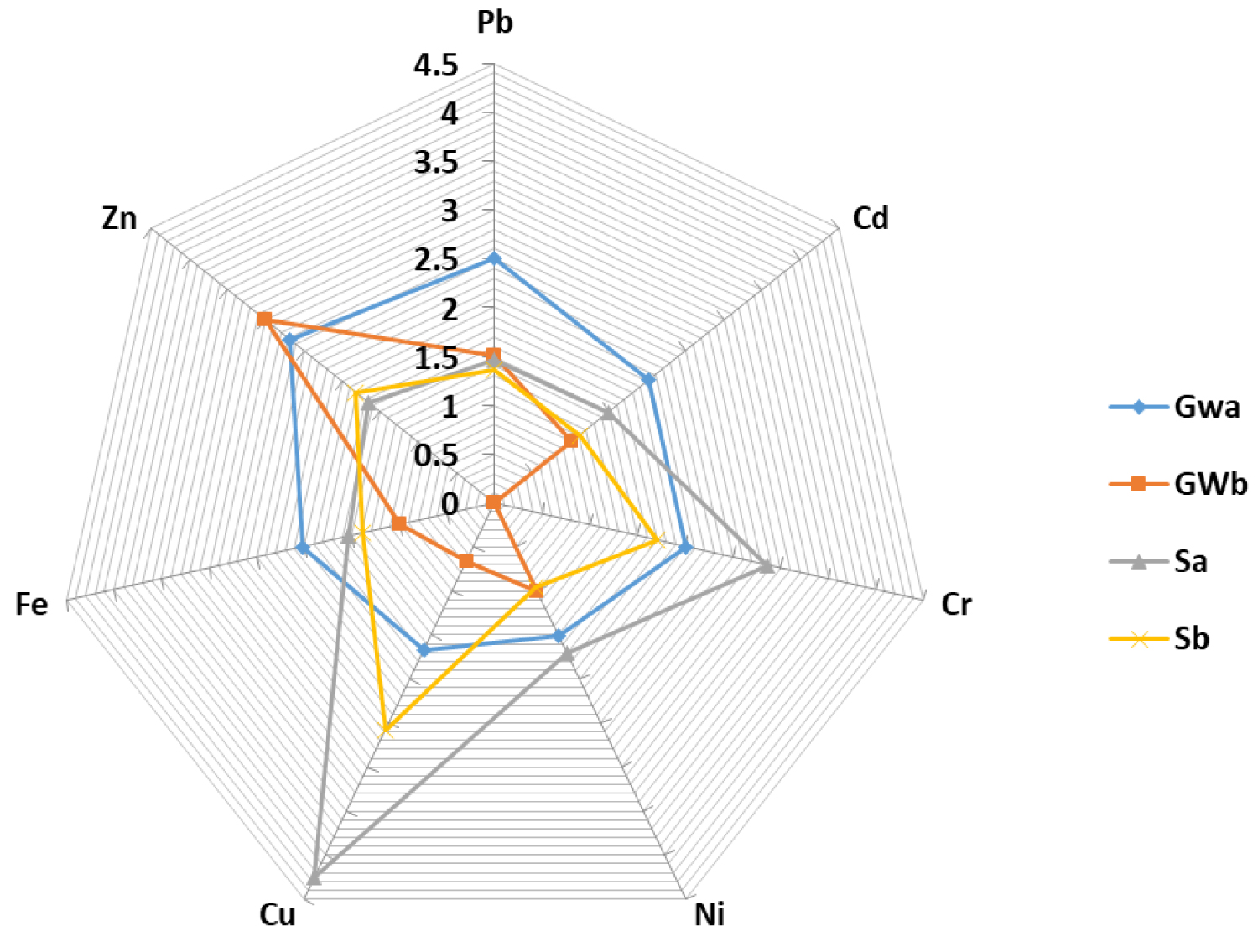 Figure 4: Enrichment Factor (EF) of heavy metals in groundwater and soil of residential area around Awotan landfill, Ibadan, Southwest-Nigeria.
View Figure 4
Figure 4: Enrichment Factor (EF) of heavy metals in groundwater and soil of residential area around Awotan landfill, Ibadan, Southwest-Nigeria.
View Figure 4
Potential Ecological Risk Index (PERI): PERI estimation of metals in the study area is represented in Figure 5. GWa poses the highest ecological risk (PERI = 97.2) followed by Sa (PERI = 90.37), then GWb (PERI = 49.85) and finally Sb (PERI = 34.21). However, the PERI estimation for all the metals are within 150.
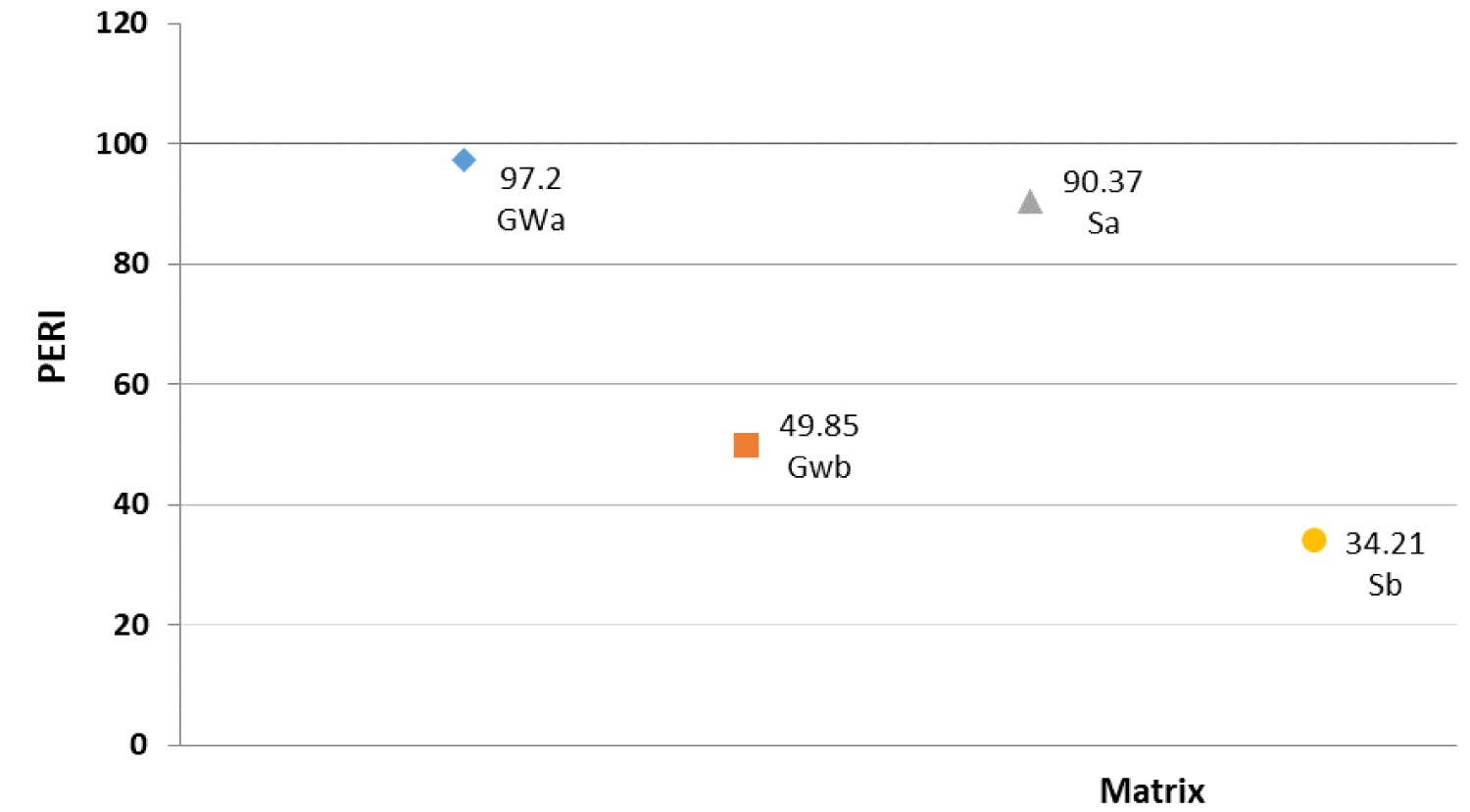 Figure 5: Potential Ecological Risk Index (PERI) of heavy metals in groundwater and soil of residential area around Awotan landfill, Ibadan, Southwest-Nigeria.
View Figure 5
Figure 5: Potential Ecological Risk Index (PERI) of heavy metals in groundwater and soil of residential area around Awotan landfill, Ibadan, Southwest-Nigeria.
View Figure 5
Hazard quotient (HQ): The results of non-carcinogenic HQ for heavy metals (Pb, Cd, Cr, Ni, Cu, Fe and Zn) in Gwa, GWb, Sa and Sb in residential area around AWL Ibadan is presented in Table 6. HQ from ingestion of water at 1-150 m radius calculated for the metals in children and adults are ˂ 1 except for Cd while that of ingestion of soil in this radius was ˃ 1 for both children and adults. Within the 151-300 m radius, HQ calculated for all metals via ingestion of water (except Cd in children which was ˂ 1) was ˃ 1 for both the age groups while for soil in this radius; the HQ was ˃ 1 for both children and adults except for Cr in adult. HQ evaluated for dermal exposure to water shows that Fe and Zn was ˂ 1 for both children adult within 1-150 m radius while those of Cu, Fe and Zn were ˂ 1 for the both age groups within 151-300 m. Meanwhile, for dermal exposure to soil in the two radii and both age groups HQ values were ˂ 1 for Ni, Cu, Fe and Zn. HQ calculated for soil inhalation for children and adult at 1-150 m and 151-300 m radii were ˂ 1.
Table 6: Hazard Quotient (HQ) associated with heavy metals in the study area. View Table 6
Hazard index (HI): Non-carcinogenic HI estimated for the metals (Pb, Cd, Cr, Ni, Cu, Fe and Zn) in Gwa, GWb, Sa and Sb in residential area around AWL Ibadan is presented in Table 7. HI due to inhalation of soil was found to be ˂ 1 for both children and adult while those due to ingestion and dermal absorption were ˃ 1 except for water ingestion by adult (with HI = 0.86) at GWb. HI values due to ingestion pathway by children were 3.77, 2.01, 8677.94 and 6848.93 while that by adults were 1.62, 0.86, 930.65 and 734.27 in Gwa, GWb, Sa and Sb respectively. HI due to dermal pathway by children were 158.63, 86.03, 57.24 and 56.51 while that by adults were 212.16, 115.31, 31.76 and 21.15 in Gwa, GWb, Sa and Sb respectively. HI for inhalation of soil was ˂ 1 for children and adults at both studied radii.
Table 7: Hazard Index (HI) of heavy metals via ingestion, dermal and inhalation routes in children and adults in residential areas around Awotan Landfill, Ibadan, Southwest-Nigeria. View Table 7
Solid wastes pose enormous environmental and health risk when found in residential homes, due to various toxic elements that are leached or transported from the hazardous components of the wastes to the adjoining groundwater and soil environment. In this study, strong positive correlation evaluated among all the metals is indicative of similarity of source and geochemical behaviour of the metals [36] while perfect associative correlation between Pb-Fe and Cr-Cu could mean that they are of absolute the same pollution and/or geochemical source. The landfill had contributed enormously, probably via runoff or underground flow, to the Cu concentration of the surrounding groundwater more than other metals analysed because Cu had the highest value of horizontal ratio (HR) in the groundwater matrix. The fact that all metals aside Zn had HR ˃ 1 could be attributed to the landfill as the source of the metals and the heavy metal transportation occurred from the landfill to the surrounding environmental matrices. Meanwhile in the case of Zn with HR ˂ 1, the parental bedrock at 151-300 m radius had possibly released the metal to the soil surface and groundwater and could not have been due to the dumpsite.
Generally, the moderate or low values of contamination factor (CF), degree of contamination (Cdeg), pollution load index (PLI), geoaccumulation index (Igeo), enrichment factor (EF) and potential ecological risk index (PERI) signifies that Awotan landfill poses low environmental risk as at the time and season when the study was carried out. However, this does not preclude potential high environmental risk at another season or upon a long time existence of the landfill. PLI ˃ 1 suggests that there is heavy metal pollution in the study area [37]; therefore it calls for corrective environmental management of the landfill. IGeo provides good index of soil pollution [38] but the results indicated practically no pollution to moderate pollution level of the study area. The result of EF further corroborate that the landfill might currently have low metal loading to the surrounding groundwater and soil but on a long run, could be aggravated through continuous accumulation and pose serious environmental and health risks. Hence, a level of anthropogenic influence resulting from the landfill had contributed to heavy metal contamination of its surrounding groundwater and soil [21]. The results of PERI for all metals implied that the landfill posed low ecological risk [34].
The calculated hazard quotient (HQ) suggested that Pb, Cr, Ni, Cu, Fe and Zn from ingestion of groundwater pose no health hazard as against Cd that could do otherwise to children and adult residing at 1-150 m distance from AWL. Furthermore, ingestion of soil within 1-150 m by children and adults pose health hazard since HQ values was not within an acceptable level of non-carcinogenic adverse health risk. Calculated HQ from ingestion of water at 151-300 m radius revealed that only children were at risk of health hazard due to Cd while other metals did not pose any health threat to children and adults. Meanwhile, the metals pose health risk hazard to children and adults (except for Cr to adults) via soil ingestion. HQ calculated from dermal exposure pathway revealed that Fe and Zn in water; and Ni, Cu, Fe and Zn in soil did not pose any health risk hazard to children and adults residing within 1-150 m radius but it is so at 151-300 m radius. The results of HQ calculated based on inhalation of soil by children and adults showed that HQ values were within acceptable range of non-carcinogenic adverse health risk as HQ was found far below 1. This implies that inhalation of soil do not pose health hazard to children and adults living within the studied radii of residential area of AWL. HI calculated suggested that exposure to contaminated soil via ingestion and dermal routes poses health risk to children and adults while via inhalation does not.
Correlation between analysed metals indicated that the metals originated from the same source. In addition, result of horizontal ratio largely revealed that heavy metals are transported from the landfill to the adjoining residential areas except for Zn which could be due to its influx from the natural bedrock present at the distant area of the landfill. Generally, environmental risk due to Awotan landfill was low or moderate as revealed by the results of estimated environmental risk indices. However, health index calculated for the heavy metals through ingestion and dermal absorptions signified health risk while that of inhalation indicated practically no health risk.
It is worthy of note that this research showed that children and those living closer to Awotan landfill were at greater health risks compared to adults and those living farther away from the landfill respectively. Therefore, people residing close to the landfill should be educated on dangers associated with living around the landfill. The landfill should be sanitarily reconstructed while concerned regulatory agency should enforce acceptable standards in managing the landfill thereafter.